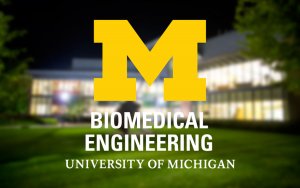Presented By: Biomedical Engineering
Feasibility of Using the Utah Array for Long-term Fully Implantable Neuroprosthesis Systems
Final Oral Examination - Autumn Bullard

Damage to the spinal cord can disrupt the pathway of signals sent between the brain and the body and may result in partial or complete loss of both motor and sensory functions. The loss of these functions can have devastating implications on the quality of one’s life, interfering with activities of daily living related to walking, bladder and bowel control, trunk stability, and arm and hand function. Current approaches used to help improve and restore mobility require residual movement to control, which can be unintuitive and inoperative by individuals with higher level cervical injuries. In order to develop technology used by individuals of all levels of injury, it is necessary to generate control signals directly from the brain. This thesis is intended to address the clinical limitations of implantable neural recording systems, and thus lay the foundation for the development of a design and safety profile for a fully implantable intracortical system for motor restoration.
We first present the design and testing of a 96-channel neural recording device used to mate with an existing functional electrical stimulation (FES) system in order to facilitate brain-controlled FES. By extracting signal power within a narrow frequency bandwidth and reducing overhead processer operations, a 25% power reduction is achieved. This establishes the feasibility for an implantable system and enables the integration of the neural recording device with implantable FES system. The specifications of this platform can be used as a guide to develop further application specific modules and dramatically accelerate the overall process to a clinically viable system.
With a functional device, the next step is to move towards a clinical trial. Here we investigate the potential safety risks of future modular, implantable neuroprosthetic systems. A systematic review of 240 articles was used to identify and quantitatively summarize the hardware-related complications of the most established intracranial clinical system, deep brain stimulation, and the most widespread experimental human intracranial system, the NeuroPort, including the Utah microelectrode array. The safety and longevity data collected here will be used to better inform future device and clinical trial design and satisfy regulatory requirements.
The stability and longevity of the Utah array are critical factors for determining whether the clinical benefit outweighs the risk for potential users. We investigate the biological adverse response to the insertion of the Utah array in a rhesus macaque. We examined the health and density of neurons around the shanks of the array in comparison to control brain. Non-human primate animal models allow us to further examine the effects of the implantation of the Utah array on neural tissue, which cannot be done with humans. Information gained through this will continue to increase the pool of safety data for the Utah array and emerging intracranial devices.
Overall, we developed a neural recording device to be used for brain-controlled FES and examined the potential safety concerns reported in the human literature and experimentally using non-human primates. These results represent significant progress towards a clinically-viable system for motor restoration in people suffering from spinal cord injury.
Chair: Cindy Chestek
We first present the design and testing of a 96-channel neural recording device used to mate with an existing functional electrical stimulation (FES) system in order to facilitate brain-controlled FES. By extracting signal power within a narrow frequency bandwidth and reducing overhead processer operations, a 25% power reduction is achieved. This establishes the feasibility for an implantable system and enables the integration of the neural recording device with implantable FES system. The specifications of this platform can be used as a guide to develop further application specific modules and dramatically accelerate the overall process to a clinically viable system.
With a functional device, the next step is to move towards a clinical trial. Here we investigate the potential safety risks of future modular, implantable neuroprosthetic systems. A systematic review of 240 articles was used to identify and quantitatively summarize the hardware-related complications of the most established intracranial clinical system, deep brain stimulation, and the most widespread experimental human intracranial system, the NeuroPort, including the Utah microelectrode array. The safety and longevity data collected here will be used to better inform future device and clinical trial design and satisfy regulatory requirements.
The stability and longevity of the Utah array are critical factors for determining whether the clinical benefit outweighs the risk for potential users. We investigate the biological adverse response to the insertion of the Utah array in a rhesus macaque. We examined the health and density of neurons around the shanks of the array in comparison to control brain. Non-human primate animal models allow us to further examine the effects of the implantation of the Utah array on neural tissue, which cannot be done with humans. Information gained through this will continue to increase the pool of safety data for the Utah array and emerging intracranial devices.
Overall, we developed a neural recording device to be used for brain-controlled FES and examined the potential safety concerns reported in the human literature and experimentally using non-human primates. These results represent significant progress towards a clinically-viable system for motor restoration in people suffering from spinal cord injury.
Chair: Cindy Chestek